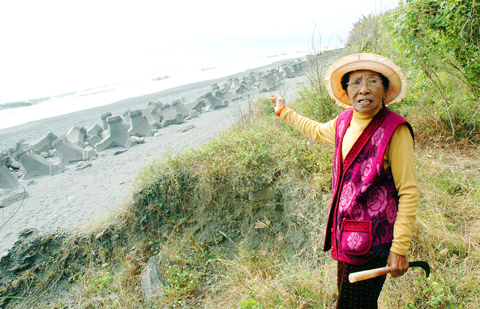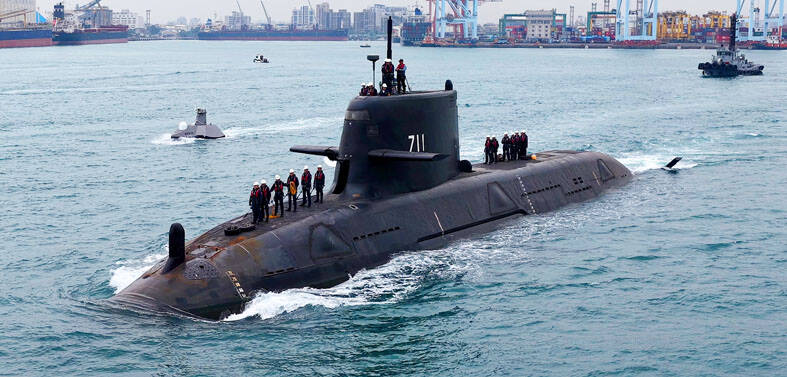Vuvu Cjuku is on a mission. For three years, the 78-year-old woman from the Paiwan tribe has headed to the southeastern coast twice a day to nurse precious pandanus seedlings she hopes will one day regain some of the plant’s former vitality.
Twenty years ago along the coast of Pingtung County’s Dawu Township (大武), there used to be wide, sandy beaches covered with pandanus — palmlike trees with a crown of narrow leaves — but the vegetation has long since disappeared, along with a major portion of the beaches.
What remains is now blighted by rows of concrete breakwaters — artificial blocks attempting to slow down beach erosion.

PHOTO: CNA
Also gone is the seaside house where Cjuku spent her childhood, one that was filled with memories of watching hermit crabs climbing up the pandanus shrubs to eat their fruit and of sea turtles coming ashore to lay their eggs.
“I wonder why all these things are nowhere to be seen now. I want to have them all back to the way they were,” she said.
Not content with simply wondering, she began her ambitious project to restore the vegetation — and consequently help stem erosion at the beach — after discovering what she believed to be the last pandanus tree on the beach three years ago.
She managed to cultivate several cuttings from the tree, but all were swamped when a typhoon hit that summer.
Miraculously, however, one of the seedlings sprouted again the following year, and now there are more than a dozen.
“When they bear fruit, we will be able to grow the trees on a larger scale,” she said.
In the eyes of many, however, the chances of the elderly lady winning her battle against natural forces are slim.
A survey of coastal areas conducted by National Cheng Kung University’s (NCKU) Department of Hydraulic and Ocean Engineering showed that many of the country’s coastal areas have been suffering from severe beach erosion for decades.
Among the worst of these cases, the coast of Kezihliao (蚵子寮) in Kaohsiung County retreated 266m between 1958 and 1987, with a total of 53 hectares of land disappearing. The shore just south of the central port of Taichung retreated 212m between 1983 and 1996, with land totaling 189 hectares disappearing.
The coast along Tainan County’s Chiku Township (七股), meanwhile, retreated 429m between 1961 and 2000.
In eastern areas, retreats of 100m were seen along the coast of Ilan County’s Toucheng Township (頭城) between 1999 and last year, 84m along Hualien County’s coast of Nanbin (南濱) and Beibin (北濱) between 1984 to 1992 and 78m south of Taitung County’s Dawu fishing port between 1978 and last year.
While waves are the primary natural force leading to erosion, some geologists believe the situation has been exacerbated by rising sea levels — a result of global warming.
Another culprit is the sharp decline in sediment volume in estuaries, the result of excessive river sand extraction and the building of reservoirs and dams that have blocked the transport of sediment needed to replenish beaches.
Hsu Tai-wen (許泰文), director of the Department of Hydraulic and Ocean Engineering at NCKU, which is conducting coastal surveys for the Water Resources Agency (WRA), said that suspended sand particles fed by those estuaries and transported by currents along the coast are the main resource for beach formation.
Erosion occurs when the upcurrent amount of sediment is less than the amount being carried away.
“The beaches are lost for good in the event of scanty deposits,” Hsu said.
In the past three years, the WRA has adopted measures to control river sand extraction and now river sand accounts for only 40 percent of the sand used in domestic construction projects, down from as much as 90 percent during the economic boom in the 1980s and 1990s.
Those efforts, however, have yet to show obvious benefits, Hsu said.
“It takes time. But at least we can see that the situation is not worsening,” Hsu said. “The retreat of the coastline, while continuing over the last 10 years, is not as drastic as during the previous decade.”
Another man-made cause of erosion is the extensive development of coastal areas. Data from the Construction and Planning Agency under the Ministry of the Interior showed that nearly 56 percent of Taiwan’s 1,349km coastline is occupied by manmade facilities, including more than 200 fishing, commercial and military ports.
Most ports are protected against sea surges by barriers that project into the ocean, such as jetties and seawalls. As these barriers interrupt the flow of suspended sand particles, sand accumulates on the upcurrent side of the seawall but fails to reach the other side, causing severe erosion, Hsu said.
Liao Wen-hung (廖文弘), a technical specialist in the agency’s Planning Division, which is running a government coastal monitoring program, said the phenomenon, called the “groin effect,” is seen around all coastal facilities in Taiwan.
Toucheng Beach in Ilan, which once stretched for 2km and had a total area equal to 60 football fields — is one such casualty. It has been vanishing since the construction more than 10 years ago of protective jetties at the Wushih fishing harbor, located just north of the beach.
For several years, the WRA has been attempting to nourish the beach by building barriers there to help accumulate sand, with little success.
Hsu said soft engineering options such as beach nourishment were better for dealing with coastal erosion despite their slow progress and high costs because they do less damage to the natural landscape.
Beach nourishment projects, however, remain rare. The first and best-known case was completed last year in Sizihwan (西子灣), Kaohsiung City, where a 5 hectare beach was restored through sand fill and a headland project to extend the life of the fill.
A similar project is currently under way near the port of Anping, Tainan.
The planting of vegetation such as pandanus and beach morning glory, which are known for their beach-stabilizing functions, should come only after lost beaches have successfully been restored by artificial means, Hsu said, a cautionary warning to the committed Vuvu Cjuku.
“If pandanus trees are grown when the beach is already gone, the sea will still swamp the area, killing the trees very quickly,” he said.

US climber Alex Honnold is to attempt to scale Taipei 101 without a rope and harness in a live Netflix special on Jan. 24, the streaming platform announced on Wednesday. Accounting for the time difference, the two-hour broadcast of Honnold’s climb, called Skyscraper Live, is to air on Jan. 23 in the US, Netflix said in a statement. Honnold, 40, was the first person ever to free solo climb the 900m El Capitan rock formation in Yosemite National Park — a feat that was recorded and later made into the 2018 documentary film Free Solo. Netflix previewed Skyscraper Live in October, after videos

NUMBERS IMBALANCE: More than 4 million Taiwanese have visited China this year, while only about half a million Chinese have visited here Beijing has yet to respond to Taiwan’s requests for negotiation over matters related to the recovery of cross-strait tourism, the Tourism Administration said yesterday. Taiwan’s tourism authority issued the statement after Chinese-language daily the China Times reported yesterday that the government’s policy of banning group tours to China does not stop Taiwanese from visiting the country. As of October, more than 4.2 million had traveled to China this year, exceeding last year. Beijing estimated the number of Taiwanese tourists in China could reach 4.5 million this year. By contrast, only 500,000 Chinese tourists are expected in Taiwan, the report said. The report

Temperatures are forecast to drop steadily as a continental cold air mass moves across Taiwan, with some areas also likely to see heavy rainfall, the Central Weather Administration (CWA) said. From today through early tomorrow, a cold air mass would keep temperatures low across central and northern Taiwan, and the eastern half of Taiwan proper, with isolated brief showers forecast along Keelung’s north coast, Taipei and New Taipei City’s mountainous areas and eastern Taiwan, it said. Lows of 11°C to 15°C are forecast in central and northern Taiwan, Yilan County, and the outlying Kinmen and Lienchiang (Matsu) counties, and 14°C to 17°C

STEERING FAILURE: The first boat of its class is experiencing teething issues as it readies for acceptance by the navy, according to a recent story about rudder failure The Hai Kun (海鯤), the nation’s first locally built submarine, allegedly suffered a total failure of stern hydraulic systems during the second round of sea acceptance trials on June 26, and sailors were forced to manually operate the X-rudder to turn the submarine and return to port, news Web site Mirror Daily reported yesterday. The report said that tugboats following the Hai Kun assisted the submarine in avoiding collisions with other ships due to the X-rudder malfunctioning. At the time of the report, the submarine had completed its trials and was scheduled to begin diving and surfacing tests in shallow areas. The X-rudder,